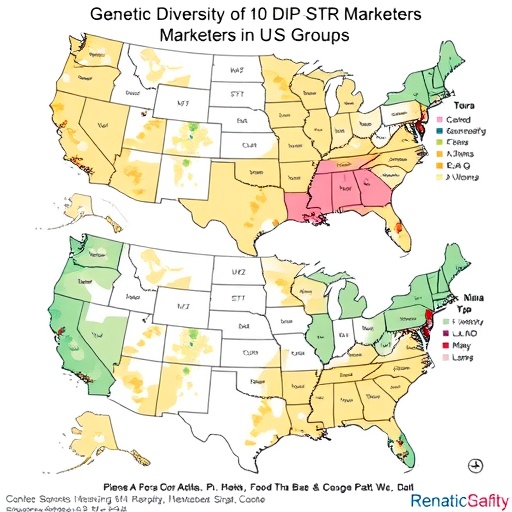
In a groundbreaking exploration into the genetic underpinnings of childhood adiposity, new research sheds light on the intricate interplay between genetics and environment in shaping three fundamental markers of body composition: body mass index (BMI), waist circumference, and percent body fat. While previous studies have underscored the considerable heritability of adiposity measures, this fresh analysis uniquely interrogates the overlapping genetic and environmental factors that simultaneously influence these three critical indices during middle childhood. The findings promise to refine our understanding of obesity’s roots and potential intervention pathways.
Obesity and adiposity have long been established as multifaceted phenomena, governed by a complex network of genetic susceptibilities and environmental exposures. Historically, heritability estimates for adiposity-related traits have consistently indicated robust genetic contributions, particularly peaking during childhood, a period marked by dynamic physiological and developmental transformations. However, most prior research has treated each adiposity metric in isolation, neglecting the possibility that the same underlying genetic or environmental factors could drive multiple phenotypic manifestations. This study pioneers a comprehensive approach, employing advanced statistical genetic models to disentangle these shared components.
At the core of this study lies the question: Is there a heritable latent factor — an unseen genetic influence — that simultaneously affects BMI, waist circumference, and percent body fat in children? To address this, the research team analyzed extensive twin-based datasets, which uniquely allow partitioning of variance into genetic, shared environmental, and non-shared environmental components. By doing so, they mapped the covariance structures among the three adiposity measures, elucidating the extent to which common genetic factors streamline these phenotypes.
.adsslot_c6y3K8uxsj{width:728px !important;height:90px !important;}
@media(max-width:1199px){ .adsslot_c6y3K8uxsj{width:468px !important;height:60px !important;}
}
@media(max-width:767px){ .adsslot_c6y3K8uxsj{width:320px !important;height:50px !important;}
}
ADVERTISEMENT
Body mass index, a widely used clinical and epidemiological tool, serves as a broad proxy for overall adiposity but fails to distinguish fat distribution or composition nuances. Waist circumference, a measure of central adiposity, correlates strongly with metabolic risks but is influenced both by fat and lean mass. Percent body fat reflects true adipose tissue proportion but requires sophisticated instrumentation to capture accurately. The convergence of these metrics within a latent heritable framework offers a richer, integrated view of the genetic architecture governing childhood adiposity.
The findings revealed an impressive degree of overlap in genetic influences across all three adiposity indicators during middle childhood. Specifically, a substantial portion of the heritable variance in BMI was shared with waist circumference and percent body fat. This supports the hypothesis of a unifying latent genetic factor that predisposes children to an overall pattern of increased adiposity, rather than isolated elevations within singular phenotypes. Such a factor could correspond to genetic variants impacting systemic energy balance, fat storage regulation, or hormonal milieu.
Interestingly, environmental influences painted a complementary yet distinct picture. While shared environmental factors, encompassing familial diet, physical activity patterns, and socioeconomic conditions, showed modest overlap, much of the environmental variance appeared unique to each phenotype. This environmental specificity suggests that despite common genetic susceptibility, diverse external factors differentially modulate the manifestation of BMI, waist circumference, and body fat percentage.
The implication of these results extends beyond academic curiosity. Understanding that a common genetic foundation partly orchestrates multiple adiposity measures calls for integrated approaches in early risk screening. Instead of relying on a single marker, clinicians might better predict predisposition and trajectory of obesity by considering a composite adiposity risk profile, genetically informed and environmentally contextualized. Moreover, pinpointing this latent genetic factor opens paths for future genomic investigations aiming to identify novel loci or pathways that could serve as therapeutic targets.
Methodologically, the study capitalized on the classical twin design, leveraging monozygotic and dizygotic twin comparisons to decompose observed phenotypic variance accurately. By applying multivariate genetic modeling, the authors transcended traditional univariate heritability estimation, simultaneously considering the covariance amongst adiposity variables. This approach enhances statistical power and precision, yielding nuanced insights into the shared versus unique etiological components shaping childhood adiposity.
Developmentally, the prominence of genetic overlap during middle childhood aligns with the physiological transitions occurring in this period. Prepubescent children exhibit substantial growth velocity and changes in body composition, underpinned by intricate genetic programming. The study underscores that these processes are coordinated, genetically influenced phenomena, affecting multiple adiposity domains concurrently. Recognizing this synchrony may reveal critical windows for intervention before adiposity patterns become entrenched.
From a public health perspective, childhood obesity remains a formidable challenge with escalating incidence worldwide, portending increased burden of metabolic syndrome, type 2 diabetes, cardiovascular disease, and psychosocial complications later in life. The elucidation of genetic commonality among adiposity traits refines risk stratification models and supports precision prevention strategies. Tailoring lifestyle or pharmacological interventions with cognizance of individual genetic profiles could amplify efficacy and sustainability.
Moreover, the partial dissociation of environmental influences implies that even in the presence of strong genetic predisposition, targeted modification of lifestyle factors can attenuate phenotypic expression. This duality underscores the importance of nurturing supportive environments in families and schools to combat obesogenic exposures, particularly for genetically susceptible children.
These cutting-edge insights open avenues for integrating genomic data with other omics layers — such as epigenomics, metabolomics, and microbiomics — to untangle the biological pathways bridging genes to adiposity phenotypes. The latent factor identified could reflect polygenic architectures or gene-by-environment interactions that merit detailed molecular characterization.
Future research endeavors will benefit from longitudinal designs tracking trajectories of BMI, waist circumference, and percent body fat, assessing stability and change of the latent genetic influence across developmental stages. Additionally, expanding analyses to diverse populations will illuminate the generalizability and potential gene-environment interplay heterogeneity across different ethnic and socioeconomic contexts.
In conclusion, this seminal study offers robust evidence for a heritable, common latent factor accounting for overlapping genetic variation in three pivotal adiposity measures during middle childhood. By integrating rigorous genetic methodologies with comprehensive phenotyping, it transforms our conceptualization of adiposity’s etiology—ushering in a new era for clinical assessment, prevention, and personalized treatment of childhood obesity. As obesity’s global impact continues to escalate, such innovations are urgently needed to shift the tide of this major public health crisis toward more effective and holistic solutions.
Subject of Research: Genetic and environmental contributions to BMI, waist circumference, and percent body fat in middle childhood
Article Title: Does a heritable common latent factor explain body mass index, percent body fat, and waist circumference across childhood?
Article References:
Bartsch, E.M., Clifford, S., Davis, M.C. et al. Does a heritable common latent factor explain body mass index, percent body fat, and waist circumference across childhood?. Int J Obes (2025). https://doi.org/10.1038/s41366-025-01864-9
Image Credits: AI Generated
DOI: https://doi.org/10.1038/s41366-025-01864-9
Tags: advanced statistical models in geneticschildhood fat percentage geneticschildhood obesity research advancementsenvironmental influences on adipositygenetic factors in childhood obesityheritability of body composition traitsintertwined genetic and environmental factorsintervention strategies for obesitymultifactorial nature of obesityphenotypic manifestations of adiposityrelationship between BMI and waist circumferenceunderstanding childhood adiposity






